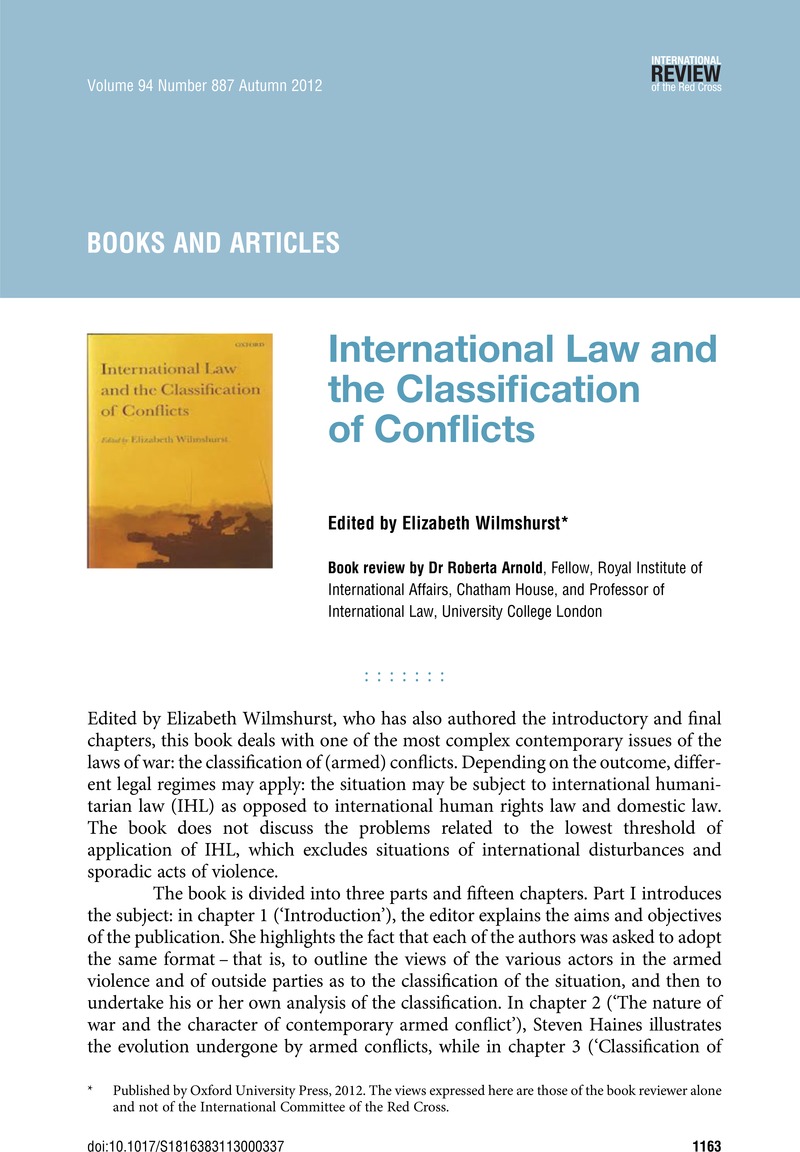Published online by Cambridge University Press: 19 August 2013

1 See ch. 14 (2), ‘Classification in future conflict’, by Michael N. Schmitt.
2 In particular, the case studies on the DRC and South Ossetia; see p. 491.
3 E. Wilmshurst, pp. 491–493.
4 In particular on the DRC, Iraq, Lebanon, Gaza, and South Ossetia, see pp. 494–495.
5 See p. 495, and the case studies on Lebanon, the DRC, and South Ossetia.
6 See ch. 3, ‘Classification of armed conflicts: relevant legal concepts’, by Dapo Akande, pp. 58–62.
7 International Court of Justice (ICJ), Military and Paramilitary Activities in and against Nicaragua (Nicaragua v. United States of America), Judgement, ICJ Reports 1986, p. 14, para. 219; ICJ, Case Concerning Application of the Convention on the Prevention and Punishment of the Crime of Genocide (Bosnia and Herzegovina v. Serbia and Montenegro), ICJ Reports 2007, p. 43, paras. 385–395.
8 International Criminal Tribunal for the Former Yugoslavia, Prosecutor v. Tadić, Case No. IT-94-1-T, Judgement (Trial Chamber), 7 May 1997 ; Prosecutor v. Tadić, IT-94-1-A, Judgement (Appeals Chamber), 15 July 1999; Prosecutor v. Tadić, IT-94-1-AR72, Decision on Defence Motion for Interlocutory Appeal on Jurisdiction (Appeals Chamber), 2 October 1995.
9 E. Wilmshurst, pp. 486–488.
10 Ibid., p. 483.
11 Ibid., p. 479.
12 Ibid., p. 479.
13 See chs 8 and 13.
14 See ch. 13, ‘The war (?) against Al-Qaeda’, by Noam Lubell; see also ch. 4, ‘Conflict classification and the law applicable to detention and the use of force’, by Jelena Pejic; ch. 5, ‘Northern Ireland 1968–1998’, by Steven Haines; and ch. 8, ‘Afghanistan 2001–2010’, by Françoise Hampson.
15 E. Wilmshurst, p. 8.
16 One may consider the Charter of the International Military Tribunal of Nuremberg of 8 August 1945 as the first international attempt to define war crimes and crimes against humanity. The text is available in ‘The Charter and Judgement of the Nuremberg Tribunal – History and Analysis: Memorandum submitted by the Secretary-General’, UN Doc. A/CN.4/5, International Law Commission, Lake Success, New York, 1949.
17 Swiss Criminal Code of 21 December 1937, SR 311.0, available in English at: http://www.admin.ch/ch/e/rs/311_0/index.html (last visited March 2013).
18 E.g. a combatant hors de combat. See the message of the Federal Council of 23 April 2008 on the modification of the federal legislation for the implementation of the Rome Statute for an International Criminal Court (‘Botschaft über die Änderung von Bundesgesetzen zur Umsetzung des Römer Statuts des Internationalen Strafgerichtshofs’), Bbl 2008, 3863, 3938, available at: http://www.admin.ch/ch/d/ff/2008/3863.pdf (last visited July 2013).
19 Art. 50, GC I (sick and wounded in the field); Art. 51, GC II (sick and wounded at sea); Art. 130, GC III (prisoners of war); Art. 147, GC IV (civilians); Art. 85, AP I (protected persons).
20 For instance, Art. 4, GC IV provides that only civilians who find themselves in the hands of a party to the conflict or occupying power of which they are not nationals can invoke the safeguards of GC IV. This proved to be a major problem for the prosecution of war crimes committed by the Nazi regime against German nationals. For more details, see Arnold, Roberta, The ICC as a New Instrument for Repressing Terrorism, Transnational Publishers, Ardsley, 2004, p. 207Google Scholar.
21 In this regard, another important aspect is the border line between IHL and international human rights law. On detention, see D. Akande, pp. 495–496, with reference to the case studies of Lebanon in 2008, the Second Congo War in the DRC, and the South Ossetian conflict; and ch. 4.
22 Depending on classification and the question of whether IHL applies at all, different rules may apply to the use of force. This holds particularly true with regard to the use of force in law enforcement operations. On this, see D. Akande, p. 495, who refers to the case studies of Iraq and Afghanistan; and chs 4 and 13.
23 E. Wilmshurst, p. 500.
24 Ibid., pp. 501–503.